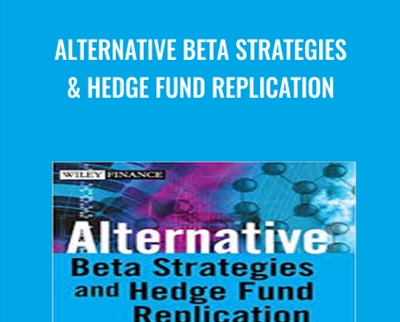$27.00 Original price was: $27.00.$11.00Current price is: $11.00.
 Purchase this course you will earn 11 Points worth of $1.10
Purchase this course you will earn 11 Points worth of $1.10Elevate your skills with the Alternative Beta Strategies & Hedge Fund Replication – Lars Jaeger course, available for just $27.00 Original price was: $27.00.$11.00Current price is: $11.00. on Utralist.com! Browse our curated selection of over 60,000 downloadable digital courses across diverse Uncategorized. Benefit from expert-led, self-paced instruction and save over 80%. Start learning smarter today!
Description
There s a buzzword that has quickly captured the imagination of product providers and investors alike: “hedge fund replication”. In the broadest sense, replicating hedge fund strategies means replicating their return sources and corresponding risk exposures. However, there still lacks a coherent picture on what hedge fund replication means in practice, what its premises are, how to distinguish di erent approaches, and where this can lead us to.
Serving as a handbook for replicating the returns of hedge funds at considerably lower cost, Alternative Beta Strategies and Hedge Fund Replication provides a unique focus on replication, explaining along the way the return sources of hedge funds, and their systematic risks, that make replication possible. It explains the background to the new discussion on hedge fund replication and how to derive the returns of many hedge fund strategies at much lower cost, it differentiates the various underlying approaches and explains how hedge fund replication can improve your own investment process into hedge funds.
Written by the well known Hedge Fund expert and author Lars Jaeger, the book is divided into three sections: Hedge Fund Background, Return Sources, and Replication Techniques. Section one provides a short course in what hedge funds actually are and how they operate, arming the reader with the background knowledge required for the rest of the book. Section two illuminates the sources from which hedge funds derive their returns and shows that the majority of hedge fund returns derive from systematic risk exposure rather than manager “Alpha”. Section three presents various approaches to replicating hedge fund returns by presenting the first and second generation of hedge fund replication products, points out the pitfalls and strengths of the various approaches and illustrates the mathematical concepts that underlie them.
With hedge fund replication going mainstream, this book provides clear guidance on the topic to maximise returns.
Table of Contents
Preface.
Breaking the Black Box.
- 1.1 New Popularity, old confusion.
- 1.2 The challenges of understanding hedge funds.
- 1.3 Leaving Alphaville.
- 1.4 The beauty of beta.
- 1.5 Alternative versus traditional beta.
- 1.6 The replication revolution.
- 1.7 Full disclosure.
What Are Hedge Funds, Where Did They Come From, and Where Are They Going?
- 2.1 Characteristics of hedge funds.
- 2.2 Hedge funds as an asset class.
- 2.3 Taxonomy of hedge funds.
- 2.4 Myths, misperceptions, and realities about hedge funds.
- 2.5 A short history of hedge funds.
- 2.6 The hedge fund industry today.
- 2.7 The future of hedge funds – opportunities and challenges.
The Individual Hedge Fund Strategiesâ?? Characteristics.
- 3.1 Equity Hedged – Long/Short Equity.
- 3.2 Equity Hedged – Equity Market Neutral.
- 3.3 Equity Hedged – Short Selling.
- 3.4 Relative Value – general.
- 3.5 Relative Value – Fixed Income Arbitrage.
- 3.6 Relative Value – Convertible Arbitrage.
- 3.7 Relative Value – Volatility Arbitrage.
- 3.8 Relative Value – Capital Structure Arbitrage.
- 3.9 Event Driven – general.
- 3.10 Event Driven – Merger Arbitrage.
- 3.11 Event Driven – Distressed Securities.
- 3.12 Event Driven – Regulation D.
- 3.13 Opportunistic – Global Macro.
- 3.14 Managed Futures.
- 3.15 Managed Futures – Systematic.
- 3.16 Managed Futures – Discretionary.
- 3.17 Conclusion of the chapter.
Empirical Return and Risk Properties of Hedge Funds.
- 4.1 When the Sharpe ratio is not sharp enough.
- 4.2 Challenges of hedge fund performance measurement – the issue with hedge fund indices.
- 4.3 Sources of empirical data.
- 4.4 Risk and Return properties of hedge fund strategies.
- 4.5 Comparison with equities and bonds.
- 4.6 Deviation from normal distribution.
- 4.7 Unconditional correlation properties.
- 4.8 Conditional returns and correlations.
- 4.9 Hedge fund behavior in extreme market situations.
- 4.10 Benefits of hedge funds in a traditional portfolio.
- 4.11 Quantitative portfolio optimization for hedge funds revisited.
- 4.12 Summary of empirical properties.
- 4.13 Appendix: Data providers for past hedge fund performance.
The Drivers of Hedge Fund Returns.
- 5.1 Alpha versus beta.
- 5.2 The enigma of hedge fund returns.
- 5.3 Hedge fund returns: how much is alpha?
- 5.4 The efficient market hypothesis.
- 5.5 Questioning the efficient market hypothesis: behavioural finance.
- 5.6 The theoretical framework of modern finance: Asset pricing models and the interpretations of alpha.
- 5.7 Systematic risk premia: The prevalence of beta in the global capital markets.
- 5.8 Risk premia and economic functions.
- 5.9 Market inefficiencies: The ‘search of alpha’.
- 5.10 An illustration on the nature of hedge fund returns.
- 5.11 The decrease of alpha.
- 5.12 The beauty of alternative beta.
- 5.13 The future of hedge fund capacity.
- 5.14 Momentum and value.
- 5.15 Active strategies and option-like returns.
- 5.16 Why manager skill matters.
- 5.17 Buyer beware: Some final words of caution about hedge fund returns.
A First Approach to Hedge Fund Replication – Linear Factor Models and Time Series Replication Models.
- 6.1 Revisiting Sharpeâ??s approach.
- 6.2 Understanding linear factor analysis: criteria for the factor model approach.
- 6.3 The model specification problem.
- 6.4 The data quality problem.
- 6.5 The development of hedge fund factor models.
- 6.6 Basic and advanced factor models for hedge fund strategies.
- 6.7 How good are our models?
- 6.8 Variability of risk exposures and persistence of factor loadings.
- 6.9 Can we create hedge fund replications with linear factor models?
- 6.10 The limitations of linear factor models.
- 6.11 Currently available hedge fund replication products based on RFS.
- 6.12 Summary and conclusion of the chapter.
The Distributional Approach.
- 7.1 Being less ambitious.
- 7.2 General principles of the distributional approach.
- 7.3 Integration of correlations and dependencies.
- 7.4 Limitations of the replication approach.
- 7.5 The empirical results of the distributional method.
- 7.6 Conclusion for the distributional approach.
Bottom up: Extraction of Alternative Beta and ‘Alternative Beta Strategies’.
- 8.1 The rule-based alternative.
- 8.2 What hedge fund investors really want.
- 8.3 The first ‘alternative beta’ strategies.
- 8.4 Relating hedge fund returns and risk premia: what we can model.
- 8.5 Alternative beta strategies for individual hedge fund styles and strategy sectors.
- 8.6 New exotic beta.
- 8.7 The question of asset allocation.
- 8.8 The limitations of hedge fund replication.
- 8.9 A note on the issue of liquidity.
- 8.10 Summary.
Hedge Fund Portfolio Management with Alternative Beta Strategies.
- 9.1 The tasks of the hedge fund portfolio manager.
- 9.2 The lure of saving fees.
- 9.3 The limitations of hedge fund replication.
- 9.The role of asset allocation.
- 9.5 Separations of tasks for the fund of funds managers.
- 9.6 The idea of a core-satellite approach to hedge fund investing.
- 9.7 Isolating pure alpha.
- 9.8 The first part in the investment process: allocation to strategy sectors.
- 9.9 Implementation of tactical asset allocation in a core-satellite approach to hedge fund portfolios.
- 9.10 The second element: manager selection.
- 9.11 Active post-investment risk management.
- 9.12 Summary and conclusion.
Replication and the Future of Hedge Funds.
- 10.1 Beyond alpha.
- 10.2 What do investors say so far?
- 10.3 Replication and the four key challenges to the hedge fund industry.
- 10.4 Replication in reality.
- 10.5 Replication and hedge fund growth.
- 10.6 Hedge funds in the broader context: The future of absolute return investment.
References and Bibliography.
Index.
Get Alternative Beta Strategies & Hedge Fund Replication – Lars Jaeger, Only Price $15
Tag: Alternative Beta Strategies & Hedge Fund Replication – Lars Jaeger Review. Alternative Beta Strategies & Hedge Fund Replication – Lars Jaeger download. Alternative Beta Strategies & Hedge Fund Replication – Lars Jaeger discount.
Cultivate continuous growth with the Alternative Beta Strategies & Hedge Fund Replication – Lars Jaeger course at Utralist.com! Unlock lifetime access to premium digital content, meticulously designed for both career advancement and personal enrichment.
- Lifetime Access: Enjoy limitless access to your purchased courses.
- Exceptional Value: Benefit from savings up to 80% on high-quality courses.
- Secure Transactions: Your payments are always safe and protected.
- Practical Application: Gain real-world skills applicable to your goals.
- Instant Accessibility: Begin your learning journey immediately after buying.
- Device Compatible: Access your courses seamlessly on any device.
Transform your potential with Utralist.com!
Related products
Uncategorized
= 85 Points
= 85 Points
Uncategorized
= 85 Points
= 84 Points
Uncategorized
Optimizing Compliance and Maximizing Revenue for Ophthalmology and Optometry – Jeffrey P. Restuccio
= 85 Points
= 84 Points
Uncategorized
= 85 Points
= 72 Points





